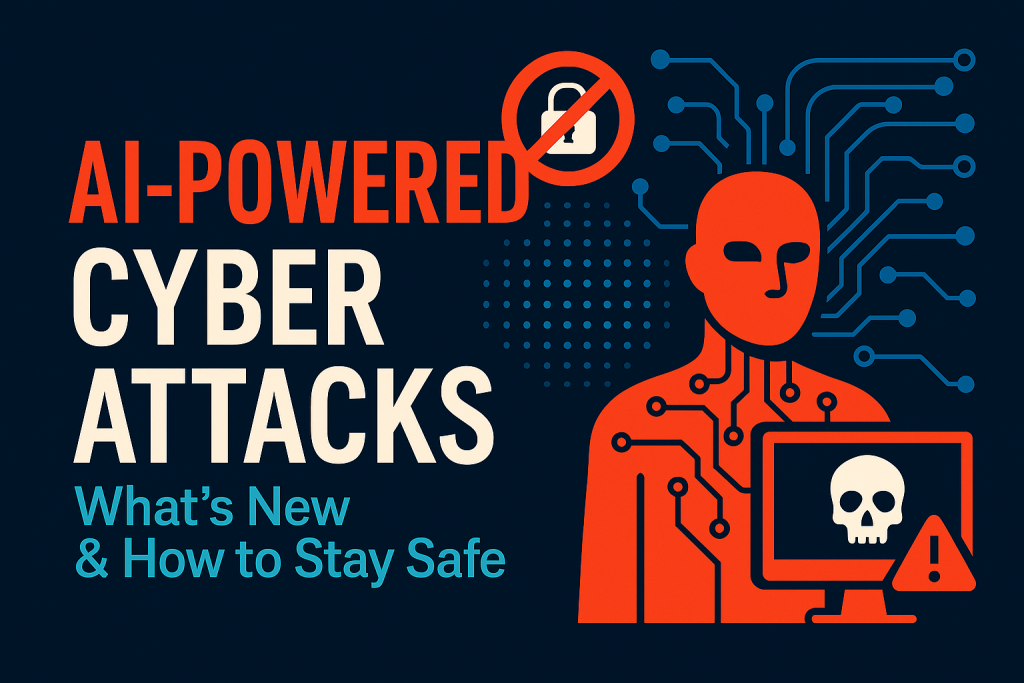Cyber Attacks, AI, and Security are now inseparable topics. What once felt like the distant future has already become today’s reality. Generative AI has transformed how attackers operate, creating threats that are faster, smarter, and harder to detect. Businesses and individuals are left asking: how do we stay safe in a world where machines are teaching themselves how to deceive us?
In this article, we’ll break down what makes AI-powered cyber attacks unique, review real-life case studies, and dive into practical strategies for defense. By the end, you’ll see how the fight against AI isn’t about fear—it’s about readiness, awareness, and resilience.
Cyber Attacks in the Age of Generative AI
Cyber Attacks have always adapted to new technology, but the arrival of generative AI has created an unprecedented shift. Attackers no longer need large teams or months of preparation. With AI, they can build convincing deepfake voices, generate personalized phishing emails, or design self-learning malware in a matter of hours.
AI doesn’t just make attacks faster. AI makes them scalable. AI makes them personalized. AI makes them frighteningly real. Imagine receiving a video call from your CEO asking you to authorize a payment—it looks, sounds, and feels authentic, yet it’s completely fabricated.
This isn’t just a technical challenge. It’s also psychological. Security experts agree that the most dangerous attacks aren’t the ones that break systems—they’re the ones that break trust. And trust is exactly what generative AI exploits.
Case Studies of AI-Powered Cyber Attacks
Deepfake CEO Scam
A European energy company became the victim of one of the first high-profile AI deepfake voice scams. Hackers cloned the CEO’s voice and convinced an employee to transfer more than $200,000. The employee believed everything matched—the accent, tone, and urgency. Traditional fraud detection didn’t flag the incident because it looked like a standard transaction request.
AI-Driven Spear Phishing
Another case involved AI-crafted spear phishing. Attackers used generative AI to study LinkedIn profiles and internal communication. Then, they generated emails that mimicked managers’ writing styles with near-perfect accuracy. Employees clicked, downloaded, and replied without hesitation because the messages felt too real to ignore.
Manipulated Medical Records
In healthcare, a cyber attack using AI tampered with patient records. Test results were altered to look legitimate, but the data was false. This wasn’t just a cyber risk—it was a life-threatening one. Security tools missed it because the data appeared normal at first glance, raising the stakes for compliance and trust.
These stories prove one thing: AI is not just changing the game—it’s rewriting the rules entirely.
AI and Security: Tools & Techniques Against Tampering
Cyber Attacks powered by AI require defenders to respond with equal intelligence. Security teams are turning to AI to detect the same threats that AI creates.
One powerful technique is behavioral biometrics. Instead of relying only on passwords or voice recognition, systems now check typing patterns, cursor movements, and even subtle pauses in speech. Deepfakes may sound real, but they can’t easily mimic human behavior at that level.
Another tool involves synthetic media detection. Specialized software scans audio and video for AI fingerprints—tiny inconsistencies in pixels, sound waves, or metadata that humans wouldn’t notice. This gives defenders an edge in spotting fakes before they spread.
Companies are also implementing continuous authentication. Rather than verifying identity only at login, systems check throughout a session. If suspicious activity emerges, the system immediately cuts access.
But tools alone aren’t enough. Employees still play a critical role. Training staff to question unexpected requests—even from “trusted” sources—creates a human firewall that AI struggles to bypass.
Policy, Compliance, and the Legal Side of AI Misuse
Security doesn’t end with technology. Policy and compliance are now major battlegrounds in the fight against AI-powered cybercrime.
For example, data protection regulations like GDPR or HIPAA mean that if AI-generated attacks compromise sensitive information, organizations face not just recovery costs but heavy fines.
Another issue is AI accountability. Companies using AI for security must show that their tools are explainable and unbiased. Regulators are pushing for transparency, and businesses that fail to comply risk legal action.
Lastly, supply chains are vulnerable. Even if your company has strong defenses, a weaker partner may become the backdoor attackers exploit. That’s why compliance strategies must extend across entire ecosystems, not just individual organizations.

10 Detailed Techniques to Stay Safe from AI-Powered Cyber Attacks
1. Deploy AI Against AI
AI can analyze patterns across millions of data points in seconds. Security teams should leverage machine learning models to detect unusual behavior, spot phishing attempts, and adapt in real time.
2. Adopt a Zero Trust Framework
Trust nothing, verify everything. Zero Trust ensures every request—whether internal or external—is checked and re-checked. This stops attackers from moving freely once inside.
3. Strengthen Behavioral Biometrics
Passwords are easy to steal. AI deepfakes can mimic voices. But typing habits, gestures, and interaction patterns are harder to copy. Adding these checks makes intrusions more difficult.
4. Use Synthetic Media Detection
Cyber Attacks increasingly use manipulated audio and video. Detection tools can identify pixel-level or audio inconsistencies that give away AI tampering.
5. Train Employees Continuously
AI-phishing works because people trust what feels familiar. Frequent, realistic training keeps staff alert and ready to pause before clicking or transferring money.
6. Harden Endpoint Security
Phones, laptops, and IoT devices are common entry points. Keeping them updated with advanced security and automated patching helps block malware before it spreads.
7. Monitor Dark Web Data Leaks
Many AI models are trained on stolen data. By watching dark web marketplaces, companies can detect when sensitive information is circulating and act early.
8. Establish Governance for AI Use
Policies guide how AI is developed and deployed internally. A strong governance framework ensures that AI security tools are transparent, monitored, and aligned with regulations.
9. Join Threat Intelligence Networks
No company can fight alone. By sharing intelligence across industries, organizations can learn from one another’s experiences and stay ahead of attackers.
10. Build Incident Response Playbooks
Prevention isn’t enough. A tested incident response plan ensures quick containment, while recovery steps like backups and communication protocols reduce long-term damage.
The Future of AI and Security
Cyber Attacks powered by AI will not fade away. They will evolve, becoming more convincing and more dangerous. But defenders aren’t standing still. Security experts are developing smarter AI, businesses are enforcing stronger governance, and policymakers are beginning to catch up.
The future of security is not about eliminating threats. It’s about resilience. It’s about combining human intuition with machine intelligence. It’s about preparing for the attacks you know—and the ones you can’t yet imagine.
Conclusion: Cyber Attacks, AI, Security in One Story
Cyber Attacks, AI, and Security now tell the same story. Generative AI-powered cybercrime is already here, and it’s changing the way businesses and individuals think about trust, technology, and defense.
The good news is that solutions exist. From AI-powered detection systems to Zero Trust frameworks, employee awareness, and governance policies, the tools are available. The challenge is not just having them—it’s using them consistently and intelligently.
In the end, staying safe isn’t just about the latest technology. It’s about mindset. It’s about knowing that the landscape has changed and being ready to adapt. Those who prepare will survive. Those who ignore the change may find themselves caught in the perfect storm of Cyber Attacks, AI, and Security.
